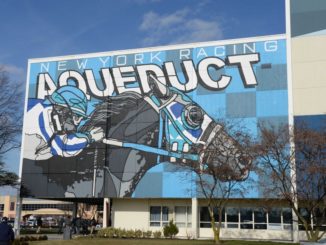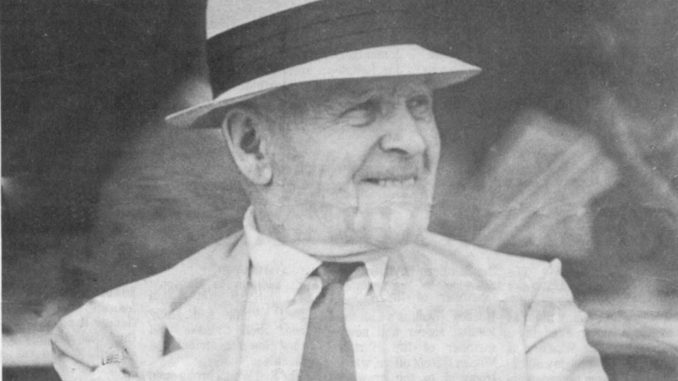
by Teresa Genaro
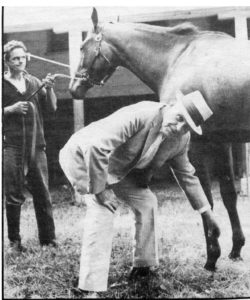
“In 1903…a skinny, pleasant lad of 15 applied for a job at the Sanford Stud Farm in Amsterdam, N.Y. His name was Hollie Hughes and he was taken on as a night watchman.” — Red Smith, “Some Reflections on a Horseman”
Hughes’ name is practically a byword for Sanford Stud Farm, the racing and breeding operation near Saratoga that gives its name to Saratoga’s historic Sanford Stakes, first run in 1913.
Hughes didn’t get his race until much later — 1979 — when he was in his early 90s. Inducted into the Hall of Fame in 1973, he talked a year later to Sports Illustrated‘s Frank Deford about his 1916 Kentucky Derby winner, George Smith. He’d become Sanford’s trainer two years before that win, and he was still training Sanford horses nearly 60 years later.
“Hollie Hughes is not the oldest Derby survivor,” wrote Deford. “But in a special way Hollie Hughes’ antiquity counts most because he is still doing precisely what he was doing on May 13, 1916: he is training horses for Sanford Stud.”
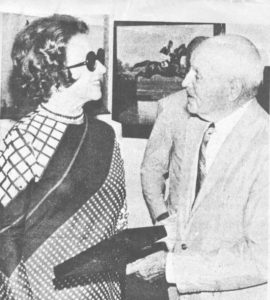
Sanford Stud was in Amsterdam, New York, about 30 miles from Saratoga, and in its early days, the farm staff — including Hughes — walked the horses to the race course. A 2008 article in the Schenectady Gazette (no longer available online) details this walk. Author Bob Cudmore quotes Hughes from Alex M. Robb’s book “The Sanfords of Amsterdam:”
“First, we’d go up to Hagaman, a couple of miles away, and then we’d head for Top Notch, or West Galway, as it’s called. That would be about five miles. Then we’d go three miles straight east to Galway village. Then wed go to West Milton, about seven miles farther east, and there we’d stop at the old Dutch Inn and feed the horses and men. My, those breakfasts tasted good! By that time it would be close to daylight. On the way over, half the horses would be under saddle with boys up. After breakfast the saddles were put on the others which had been led by the men up to this point, and we’d walk the remaining 10 miles to Saratoga, coming in by Geyser Spring.”
Hughes is not exactly a household racing name, but as recently as 1998, New York Times author George Vecsey was quoting him in a column wondering how long the racing world would have to wait for another horse as good as Secretariat.
“Ron Turcotte, Secretariat’s jockey, has often told how Hollie Hughes, the trainer of the 1916 Derby winner, George Smith, was still around in 1973 just before the Belmont.
“‘Son, you’re riding the greatest horse that ever looked through a bridle,’ Hughes told Turcotte. ‘I have seen them all, including Man o’ War. Secretariat is the best I’ve ever seen. You will win the Belmont. Don’t fall off.'”
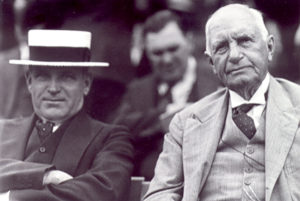
Hughes died in 1981. In addition to that Kentucky Derby, he also won six American Grand Nationals, earning perhaps more acclaim as a steeplechase trainer than on the flat. He won the 1949 Whitney with Round View and retired from training in 1975 at age 87. He never did make it back to the Kentucky Derby.
“A few years later I had a horse named Snob,” Hughes said in that Sports Illustrated article, “and I told Mr. Sanford we ought to put him in the Derby because he might win. But Mr. Sanford could be a peculiar man. He said, ‘I have won one Derby. I have no desire to win any other.’ So I never had any reason to go back.”
At Aqueduct today, Hollie Hughes will be honored with his eponymous race, though it’s odds-on that few in the crowd will know anything about the man who gives the feature its name; the man who — according to Louis Hildebrandt Jr., president of the board of Friends of Sanford Stud Farm and the son of a jockey who worked for Hughes and the Sanfords for more than a decade — was “the glue of the whole (Sanford) organization.”

